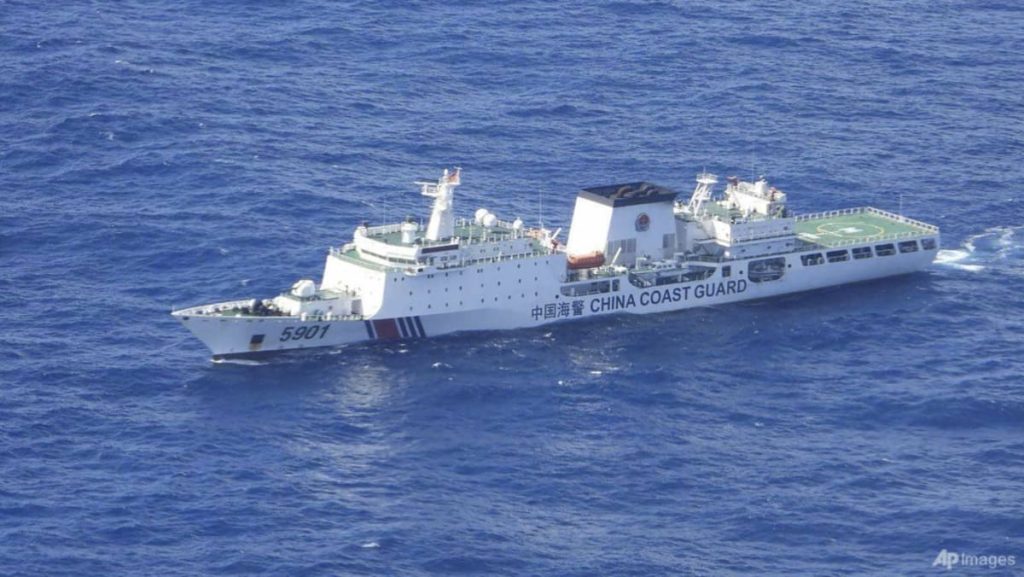The escalating tensions in the South China Sea between the Philippines and China reached a new crescendo with the recent deployment of China’s largest coast guard vessel, the CCG 5901, within the Philippines’ Exclusive Economic Zone (EEZ). This action, perceived by Manila as an act of intimidation against Filipino fishermen and a blatant disregard for international maritime law, has further strained the already fragile relationship between the two nations. The Philippines contends that the presence of the massive vessel, nicknamed the “monster ship,” near Scarborough Shoal, a disputed territory within the Philippines’ EEZ, is an unwelcome escalation of China’s assertive posture in the region. The deployment of the CCG 5901 underscores the ongoing struggle for control over vital fishing grounds and strategic maritime resources in the contested waters.
The Philippines’ National Security Council, through its spokesperson Jonathan Malaya, has vehemently condemned the deployment of the CCG 5901, labeling it as “provocative,” “illegal,” and “unacceptable.” Malaya emphasized that the presence of the massive coast guard vessel is a clear attempt to intimidate Filipino fishermen and deprive them of their livelihoods in their own territorial waters. This latest incident comes on the heels of a series of incursions by Chinese vessels into the Philippines’ EEZ, raising concerns in Manila about Beijing’s growing assertiveness and its disregard for international maritime norms. The Philippines argues that these actions violate its sovereign rights within its EEZ, as defined by the United Nations Convention on the Law of the Sea (UNCLOS).
Scarborough Shoal, a traditional fishing ground for Filipino fishermen, has been a flashpoint in the maritime dispute between the two countries. China’s claim to the shoal, which it refers to as Huangyan Dao, overlaps with the Philippines’ EEZ. The 2016 ruling by the Permanent Court of Arbitration in The Hague invalidated China’s expansive “nine-dash line” claim in the South China Sea, but Beijing has consistently refused to recognize the ruling. The deployment of the CCG 5901 is seen by Manila as another attempt by Beijing to assert its control over the disputed territory and solidify its presence in the region, further complicating the already complex situation.
China, in response to the Philippines’ accusations, maintains that Scarborough Shoal is an inherent part of its territory and that its actions are within the bounds of law. The Chinese embassy in Manila defended the deployment of the CCG 5901, stating that it is fully justified and in accordance with Chinese law. This stark contrast in perspectives underscores the deep-seated disagreement between the two nations and highlights the challenges in finding a peaceful resolution to the South China Sea dispute. China’s continued disregard for the international ruling and its assertive actions in the region have fueled concerns about its long-term intentions and the potential for further escalation.
The escalating tensions in the South China Sea have broader implications for regional stability and international relations. The Philippines, a US treaty ally, has increasingly looked to its long-time security partner for support in the face of China’s growing assertiveness. The US has reaffirmed its commitment to upholding freedom of navigation and overflight in the South China Sea and has conducted joint military exercises with the Philippines in the region. These actions underscore the strategic importance of the South China Sea and the growing concern over China’s attempts to control the vital waterway.
The presence of the CCG 5901 in the Philippines’ EEZ represents a significant escalation in the ongoing maritime dispute between the two countries. The Philippines’ strong condemnation of China’s actions and its appeal for international support underscore the seriousness of the situation. As tensions continue to rise, the need for a diplomatic solution to the South China Sea dispute becomes increasingly urgent. The international community plays a crucial role in encouraging dialogue and peaceful resolution to prevent further escalation and ensure stability in this strategically important region. The ongoing dispute serves as a reminder of the complex interplay of national interests, international law, and the delicate balance of power in the South China Sea.

